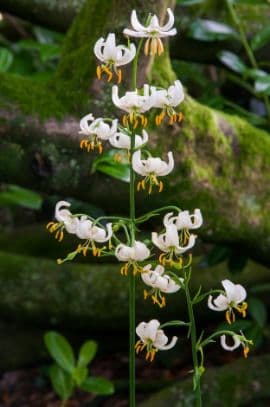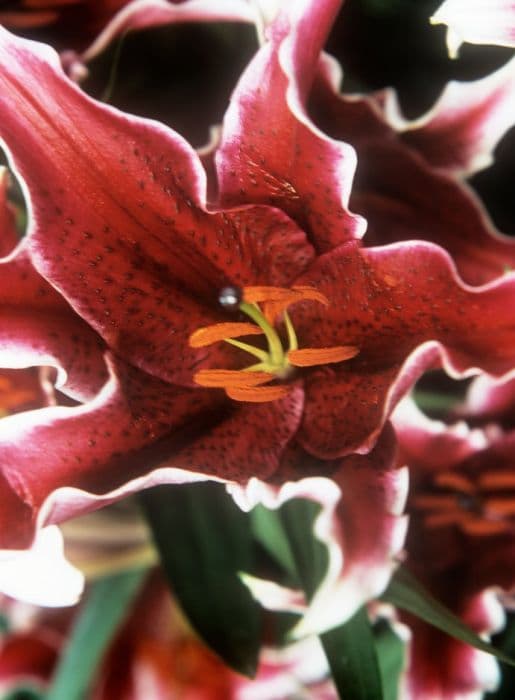Tulip Tulipa 'Gavota' (3)

ABOUT
Tulipa 'Gavota' is a striking variety of tulip known for its unique and dramatic coloring. This plant features a flower that has rich, maroon or deep purplish-red petals, each edged with a broad margin of creamy yellow, creating a striking contrast. The colors may sometimes seem to merge and blend, which makes each individual flower appear almost hand-painted. The shape of the blooms is the classic tulip cup shape, which opens up wide in full sun but remains more closed when in the shade or during cloudy weather. The flower sits atop a sturdy green stem, surrounded by lance-shaped, medium green leaves that are typically smooth and have a somewhat waxy surface which gives them a bit of a sheen. The overall look of Tulipa 'Gavota' is elegant and sophisticated, making it a popular choice for gardeners looking to make a strong visual impact in their spring garden displays.
About this plant
 Names
NamesFamily
Liliaceae
Synonyms
Gavota Tulip, Triumph Tulip
Common names
Tulipa 'Gavota'
 Toxicity
ToxicityTo humans
The Tulip is considered to have low toxicity to humans. While not typically life-threatening, ingestion of any part of the plant—especially the bulb—can cause symptoms such as nausea, vomiting, diarrhea, and abdominal pain.
To pets
The Tulip is toxic to pets like cats and dogs. Eating any part of the plant can lead to symptoms including gastrointestinal irritation, drooling, loss of appetite, depression of the central nervous system, convulsions, and cardiac abnormalities. The bulb contains the highest concentration of toxic compounds, so it poses the greatest risk.
 Characteristics
CharacteristicsLife cycle
Perennials
Foliage type
Deciduous
Color of leaves
Green
Flower color
Mixed
Height
1-2 feet (30-60 cm)
Spread
6 inches (15 cm)
Plant type
Bulb
Hardiness zones
3
Native area
Central Asia
Benefits
 General Benefits
General Benefits- Aesthetic Appeal: Tulipa 'Gavota', commonly known as tulip, features unique maroon and yellow bi-colored petals that add visual interest to any garden or floral arrangement.
- Easy to Grow: Tulips are beginner-friendly and can be grown with minimal gardening experience, making them suitable for a wide range of gardeners.
- Attracts Pollinators: Their bright flowers can attract beneficial pollinators such as bees and butterflies, which help pollinate other plants in the garden.
- Seasonal Color: Tulips bloom in spring, providing early color in the garden after a long winter, and marking the beginning of the growing season.
- Symbolism and History: Tulips carry various symbolic meanings and have a rich history, particularly associated with Dutch Tulip Mania, making them a plant with both beauty and story.
- Variety of Uses: They are versatile and can be used in beds, borders, pots, and as cut flowers, offering numerous design possibilities in landscaping and floral crafts.
- Perennial Growth: While some tulip varieties are treated as annuals, many can come back for several years if the growing conditions are favorable, providing long-term value.
 Medical Properties
Medical PropertiesThis plant is not used for medical purposes.
 Air-purifying Qualities
Air-purifying QualitiesThis plant is not specifically known for air purifying qualities.
 Other Uses
Other Uses- Photography subject: Tulipa 'Gavota', with its striking color contrast, is often used by photographers to create visually dynamic floral portraits and still-life imagery.
- Artistic inspiration: The unique pattern and coloration of the tulip can inspire artists in creating paintings, textiles or other visual arts.
- Educational tool: Horticulturalists and educators might use Tulipa 'Gavota' to demonstrate hybridization techniques and color genetics in plants.
- Culinary decoration: The flowers can be used to garnish and decorate food dishes, although they should not be consumed unless specifically marked as edible.
- Wedding décor: They can be integrated into floral arrangements and wedding bouquets for their bold and dramatic appearance.
- Crafting: Dried petals of Tulipa 'Gavota' can be used for creating bookmarks, greeting cards, or other crafts.
- Color dye source: The pigments from the petals may be used to naturally dye fabrics or papers, though its colorfastness may vary.
- Aromatherapy: While not a typical use, the subtle scent of the tulip may be incorporated into potpourri blends for a light floral touch.
- Theme gardens: This tulip variety can be used to create a focused color scheme in theme gardens, such as 'chocolate' or 'contrasting colors' gardens.
- Symbolic gift: In flower language, tulips can represent perfect love, and gifting the 'Gavota' variety might add an extra layer of uniqueness to the sentiment.
Interesting Facts
 Feng Shui
Feng ShuiThe tulip is not commonly referenced in traditional Feng Shui practice.
 Zodiac Sign Compitability
Zodiac Sign CompitabilityThe tulip is not used in astrology practice.
 Plant Symbolism
Plant Symbolism- Love: Tulips are often associated with perfect love and the 'Gavota' variety's deep, romantic colors could evoke deep passion and commitment in this context.
- Ephemeral beauty: The tulip, including the 'Gavota', signifies the brief nature of life with its transient bloom signaling the importance of seizing the moment.
- Royalty and nobility: The rich, maroon color edged with golden yellow of the 'Gavota' tulip can represent regal splendor and elegance, imbuing it with a sense of dignity and majesty.
- Charity: In some interpretations, tulips are a symbol of charity, possibly due to their generous bloom and the way they enrich the beauty of their surroundings.
 Water
WaterTulip 'Gavota' thrives with moderate watering during their growth period, generally in the spring. They should be watered thoroughly to soak the soil when the top inch feels dry to the touch, which may be approximately once a week. The exact frequency depends on climate and weather conditions, but it's essential to avoid overwatering as this can lead to bulb rot. A good rule of thumb is to provide around 1 gallon of water per square yard every week during the active growth period, tapering off after the flowers have bloomed and leaves begin to yellow and die back.
 Light
LightTulip 'Gavota' requires full sun to light shade to flourish. They perform best with at least 6 hours of direct sunlight per day. The ideal spot for these tulips is an area that receives morning sunlight and is protected from the intense heat of late afternoon sun, which can scorch the flowers.
 Temperature
TemperatureTulip 'Gavota' can tolerate a range of temperatures but prefers the cooler conditions typical of spring weather. The ideal temperature range for these tulips is between 60°F and 70°F during their growth period. They can withstand winter cold down to around 20°F, and summer dormancy should be in a dry place with temperatures below 75°F.
 Pruning
PruningTulip 'Gavota' typically doesn't require pruning in the traditional sense but deadheading, removing spent flowers, is beneficial. This prevents the plant from using energy to produce seeds and encourages the bulb to store more energy for the next season. Deadhead the tulips as soon as the flowers fade, but leave the foliage in place until it turns yellow and dies back naturally, usually several weeks after blooming.
 Cleaning
CleaningNot needed
 Soil
SoilTulip 'Gavota' thrives in well-draining, fertile soil with a neutral to slightly acidic pH of 6.0 to 7.0. A good mix is equal parts of loamy soil, compost, and sharp sand or perlite to ensure adequate drainage. This tulip variety benefits from a top dressing of compost or well-rotted manure in the fall.
 Repotting
RepottingAs a bulbous perennial, Tulip 'Gavota' does not require frequent repotting. Instead, bulbs should be lifted and divided every 3 to 5 years to avoid overcrowding and to maintain vigor. Best repotting practice is after foliage has died back and the bulb is dormant, typically in late summer or fall.
 Humidity & Misting
Humidity & MistingTulip 'Gavota' prefers outdoor conditions where humidity is generally not controlled and it adapts to the ambient humidity of its environment. This tulip variety does not require specific humidity levels when grown outdoors and is tolerant of a wide range of humidity conditions.
 Suitable locations
Suitable locationsIndoor
Place 'Gavota' tulip bulbs in a cool, sunny window, water sparingly.
Outdoor
Plant 'Gavota' tulips in full sun to part shade and in well-draining soil.
Hardiness zone
3-8 USDA.
 Life cycle
Life cycleThe tulip 'Gavota' (3) begins its lifecycle as a bulb planted in the fall, several weeks before the ground freezes. Once the temperatures rise in spring, the bulb breaks dormancy and produces a shoot that grows into a stem with leaves and a single flower. The flower blooms, showcasing its distinctive maroon and yellow petals, typically in mid to late spring. After flowering, the tulip 'Gavota' enters a period of seed production if pollinated; however, gardeners often remove spent flowers to redirect energy to the bulb. The above-ground foliage dies back as the plant enters a period of dormancy during the warm summer months. The cycle repeats the following spring, with the mature bulb potentially producing offset bulbs that can be separated and planted to grow new plants.
 Propogation
PropogationPropogation time
Spring
Tulip 'Gavota', a beautiful and distinctive cultivar, is typically propagated through the division of its bulbs, which is the most common method for multiplying tulips. Propagation time is ideally in the fall, when the temperatures start to cool but before the ground freezes. To propagate, carefully lift the mother bulb from the soil after the foliage has died back, which is a sign that the bulb is dormant, usually a few weeks after blooming. Each large bulb will likely have developed smaller offset bulbs, known as bulblets or daughter bulbs, which are clones of the original. Gently separate these bulblets from the main bulb by hand. Plant them immediately at a depth of about 6 to 8 inches (15 to 20 centimeters) in well-draining soil and at a spacing of about 4 to 6 inches (10 to 15 centimeters) apart, ensuring the pointed end is facing upward. These daughter bulbs will develop roots and foliage in the fall, lie dormant during winter, and then bloom in the spring.




![Lily [Roselily Chelsea]](/_next/image?url=https%3A%2F%2Fplants-admin.emdemapps.com%2Fimages%2Fplants%2F%2Fimages%2F604b584f6f830.png&w=640&q=75)




